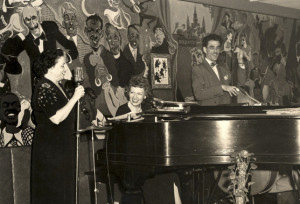 Legend has it that Dorothy Sloop, nicknamed Sloopy, was the song’s inspiration. A native of Steubenville, Ohio, she was a jazz musician who played piano with numerous female bands from the 1930s through the ’50s. In 1957, she and jazz vocalist and clarinetist Yvonne “Dixie” Fasnacht released an album called “Dixie and Sloopy,” and performed regularly at Dixie’s Bar of Music on Bourbon Street in New Orleans.
Legend has it that Dorothy Sloop, nicknamed Sloopy, was the song’s inspiration. A native of Steubenville, Ohio, she was a jazz musician who played piano with numerous female bands from the 1930s through the ’50s. In 1957, she and jazz vocalist and clarinetist Yvonne “Dixie” Fasnacht released an album called “Dixie and Sloopy,” and performed regularly at Dixie’s Bar of Music on Bourbon Street in New Orleans.
It’s rumored that the now-deceased composers of “Hang on Sloopy,” Wes Farrell and Bert Russell Berns, may have frequented Dixie’s club, and took notice of the woman with the funny nickname. But details regarding the song’s title are a mystery to this day. It seems that no one really knows if the two men ever actually met the pianist.
“Hang on Sloopy,” which hit the #1 spot on the Billboard charts on this date in 1965, was originally recorded by The Vibrations in 1964. But it was the version released by the Ohio-based Rick and the Raiders — renamed The McCoys to avoid confusion with Paul Revere and The Raiders — that became one of rock’s most enduring singles. The song features lead vocals by 16-year-old band leader Rick Zehringer, thereafter known as Rick Derringer, who would go on to a long career as a singer, guitarist and producer.
“Hang on Sloopy” quickly became a jukebox favorite at the CharBar near the main entrance to Ohio State University in Columbus. Soon, the OSU marching band began playing the song during football games. The crowd loved it, and it quickly became the band’s anthem. To this day, it’s played before the start of the fourth quarter of every O.S.U. Buckeye game.
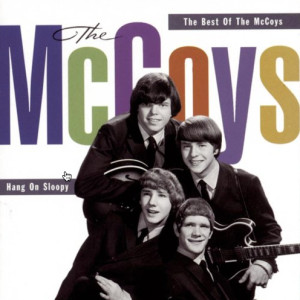 It’s since become the official song of Major League Baseball’s Cleveland Indians, AND the official rock song of the State of Ohio. (All states have songs – usually ballads, waltzes, and folk songs – but Ohio is the only one to have an official rock song (“Louie Louie” is the unofficial rock song of Washington state!)
It’s since become the official song of Major League Baseball’s Cleveland Indians, AND the official rock song of the State of Ohio. (All states have songs – usually ballads, waltzes, and folk songs – but Ohio is the only one to have an official rock song (“Louie Louie” is the unofficial rock song of Washington state!)
Sloopy is also played during the Cleveland Cavaliers’ home-court basketball games, and at the end of the 3rd quarter of most Cleveland Browns home football games.
So, what became of Dorothy Sloop? She didn’t learn of her connection to the hit song until years later when she was working for a children’s TV program in Lubbock, Texas. Although her daughter Jane Heflick said Dorothy was very pleased to serve as the song’s inspiration, she never sought royalties and only briefly mentioned the record in her personal memoir. Following her jazz career, she earned a master’s degree and taught special education for three decades in St. Petersburg, FL, passing on at age 84.
Now, what’s the origin of The Beach Boys’ “Sloop John B”? That’s a topic for another discussion.
Here are The McCoys with their only #1 hit. Feel free to sing along.
© Dana Spiardi, Sept 2, 2014
]]>
By September 1963 the band was fast becoming a phenomenon in England, but couldn’t manage to grab the attention of a major record label in the U.S. Beatles’ manager Brian Epstein finally turned to the small Philadelphia-based Swan Records to release the single that was flying off the shelves in the U.K. The label began releasing “She Loves You” singles with white labels and red text (some of those original 45s are now worth $5,000). The phrase DON’T DROP OUT is stamped on the upper left corner, to encourage kids to stay in school. In January of ’64, Swan introduced 5 black label versions, all of which contain slight variations. Later in the year, they released a version with a white label and blue text. “She Loves You” b/w “I’ll Get You” was the only Beatle record released by the label.

My very worn copy (bottom right, in banner pic) is an original from March 1964. It’s the actual disc that was played thousands of times on the jukebox in my grandparents’ tavern. It snaps, crackles and pops — its grooves are barely even visible — yet I played that record all my life, because that was how I discovered The Beatles.
Capitol Records, the band’s U.S. label, never released “She Loves You” as a single (aside from a special red vinyl pressing in 1992); they clearly weren’t interested in the band at the time of the record’s U.K. release in August 1963. But by February of the following year, Capitol would be in a mad dash to release every available bit of Beatles material, and included the song on “The Beatles’ Second Album,” a compilation LP available only in the U.S.
Paul said that he and John began writing the song on a tour bus, and finished it up in a hotel room: “John and I, sitting on twin beds with guitars.” Upon hearing an early acoustic version, Paul’s father Jim suggested they change the opening lyric to “She loves you, yes, yes, yes.” Doesn’t quite have the same ring, does it? The band recorded the song at EMI Records’ Abbey Road Studios on July 1, 1963 – less than a week after it was written. It ended up being the Beatles’ biggest-selling single in the U.K.
The song’s structure was unique for its day: the lyrics are NOT written in the first person; rather, the narrator acts as a go-between for estranged lovers. You know it’s up to you / I think it’s only fair / pride can hurt you, too / apologize to her.
Plus, the song OPENS with the hook – She loves you, yeah, yeah, yeah – not the usual verse or two. The 4th “yeeeeeaah” (a major sixth chord) in the beginning and ending chorus was George Harrison’s idea. Producer George Martin thought it was a cheesy gimmick and ruled against it, but the boys persisted. I can’t imagine the song without it.
“She Loves You” is the first Beatles record I ever heard, the first single I ever owned, and is still my all-time sentimental favorite. Ivan Pavlov could have had a field day with me — playing the song ad infinitum and gauging my heart-pounding reaction to that opening drum roll.
Take a listen.
And, just for fun, here’s “Sie Liebt Dich” – the version of the song The Beatles recorded in German. The “oooohs” are the same in any language. The boys had cut their teeth in the clubs of Hamburg in the early ’60s, and had a large following there.
© Dana Spiardi, July 1, 2014
]]>So, what song could the defense attorney possibly be citing? It’s 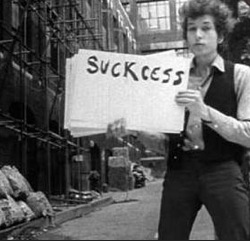 Bob Dylan’s word-twister from 1965, “Subterranean Homesick Blues,” one of the most influential and imitated songs in popular music. With its random satirical lyrics delivered in rapid-fire deadpan style, Bob takes aim at the emerging social strife of the day: civil rights battles (better stay away from those that carry around a fire hose), the burgeoning drug scene (Johnny’s in the basement mixing up the medicine), and authority figures (don’t follow leaders / watch the parking meters.) It’s like a sociopolitical jump rope chant.
Bob Dylan’s word-twister from 1965, “Subterranean Homesick Blues,” one of the most influential and imitated songs in popular music. With its random satirical lyrics delivered in rapid-fire deadpan style, Bob takes aim at the emerging social strife of the day: civil rights battles (better stay away from those that carry around a fire hose), the burgeoning drug scene (Johnny’s in the basement mixing up the medicine), and authority figures (don’t follow leaders / watch the parking meters.) It’s like a sociopolitical jump rope chant.
But the lyric that’s best remembered is: You don’t need a weatherman to know which way the wind blows. And, according to a 2007 study by Alex Long, that line has been quoted by judges, lawyers, and law scholars more than any other lyric from popular music. Mr. Long is a University of Tennessee law professor who spent an entire semester back in 2007 researching the use of popular song lyrics in court findings and legal publications. He found that half a dozen California appellate court rulings have used Dylan’s weatherman line to show that testimony is unnecessary to make a point that would be obvious to any layman.
Bob Dylan’s poetic, often stinging lyrics have long served as a social barometer. In addition to “Subterranean Homesick Blues,” many of his tunes have shown up in legal proceedings and briefs. According to Long, as of 2007, Dylan, lines had been quoted 186 times. Compare this to the lyrics of The Beatles, 74; Bruce Springsteen, 69; Paul Simon, 59; Woody Guthrie, 43; the Rolling Stones, 39; the Grateful Dead, 32; Simon & Garfunkel, 30; Joni Mitchell, 28; and R.E.M., 27.
So, if you ever get hauled before the judge, you’d better hope your lawyer was a ’60s hipster or a modern day Dylan devotee. To paraphrase Bobby: better stay away from those / who Dylan songs they don’t knows.
Below is a short commentary on the making of the famous “Bob in the alley” music video for “Subterranean Homesick Blues.” It’s from D.A. Pennebaker’s Dylan documentary, “Don’t Look Back.” Saint Allen Ginsberg is in the background – on the pavement, thinking about pissing off the government. Bob once said he based the lyrical style of the song on Chuck Berry’s famous scat record “Too Much Monkey Business.“
© Dana Spiardi, May 24, 2014
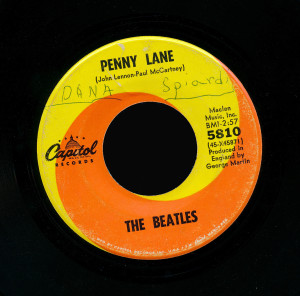 Forty-seven years ago this month, the Beatles released their 24th U.S. single, a double A-side record featuring two songs inspired by John Lennon and Paul McCartney’s childhood memories of Liverpool: “Strawberry Fields Forever” and “Penny Lane.” Paul wrote the idyllic “Penny Lane” based on happy recollections of the suburban Liverpool street where he and John would meet to catch the bus to the city center. John named his surreal “Strawberry Fields Forever” after a Salvation Army children’s home near the gardens where he played as a boy. (Interestingly, John originally planned to incorporate Penny Lane and other Liverpool haunts into one of his earlier nostalgic songs, “In My Life,” but he ended up dropping all references to specific landmarks.)
Forty-seven years ago this month, the Beatles released their 24th U.S. single, a double A-side record featuring two songs inspired by John Lennon and Paul McCartney’s childhood memories of Liverpool: “Strawberry Fields Forever” and “Penny Lane.” Paul wrote the idyllic “Penny Lane” based on happy recollections of the suburban Liverpool street where he and John would meet to catch the bus to the city center. John named his surreal “Strawberry Fields Forever” after a Salvation Army children’s home near the gardens where he played as a boy. (Interestingly, John originally planned to incorporate Penny Lane and other Liverpool haunts into one of his earlier nostalgic songs, “In My Life,” but he ended up dropping all references to specific landmarks.)
When it came to musical styles, John and Paul were often yin and yang personified. “Penny Lane,” with its spritely trumpet flourishes, is as chipper and straightforward as the multi-layered “Strawberry Fields Forever” is sad and mysterious.
I was seven years old when I bought this 45 rpm record after hearing “Penny Lane” on the radio. It was the perfect little tune for a child, with its storybook-like references to the barber, the banker, the fireman, and the pretty nurse selling poppies from a tray. In time I would discover the meaning of the song’s British terminology.
I would learn that a “mac” is short for Mackintosh, a waterproof raincoat. “Four of fish” refers to four pennies’ worth of fish and chips. The poppies are to be worn on Armistice Day to honor the lost souls of WWI. A “roundabout” is a circular intersection, common in England. And, as for “finger pie”…well, I’ll leave it to your imagination. I like to keep my blog clean. It’s a clean machine.
But then I flipped the record over, and entered a completely different world. My puzzlement over a few words in “Penny Lane” was nothing compared to my bewilderment over the imagery in “Strawberry Fields Forever.” My child brain was baffled:
Always, no sometimes, think it’s me,
but you know I know when it’s a dream.
I think I know, I mean a ‘yes’ – but it’s all wrong,
that is I think I disagree.
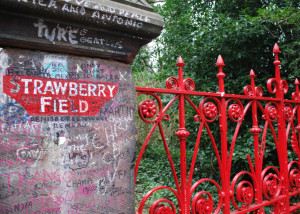 I discovered something way back then, and it’s been with me all my life: it doesn’t really matter if I don’t understand the meaning, message, or critic’s opinion of a piece of art – be it a song, a film or a painting. What’s most important is how it makes me feel. And there is no other Beatles’ song that makes me feel the way that “Strawberry Fields Forever” does. As I entered my bluesy, oddball, often solitary teenage years, I came to believe that if the Beatles produced one song specifically targeted to my soul, this was it. Even if no one else understood me, John Lennon surely did: Let me take you down…No one I think is in my tree…living is easy with eyes closed, misunderstanding all you see…it doesn’t matter much to me. Lyrically and musically, “Strawberry Fields” is the perfect eccentric song for the self-absorbed, mood-spinning outsider — far surpassing Paul Simon’s maudlin “I Am A Rock” or Janis Ian’s weepy (but wise) “At Seventeen.”
I discovered something way back then, and it’s been with me all my life: it doesn’t really matter if I don’t understand the meaning, message, or critic’s opinion of a piece of art – be it a song, a film or a painting. What’s most important is how it makes me feel. And there is no other Beatles’ song that makes me feel the way that “Strawberry Fields Forever” does. As I entered my bluesy, oddball, often solitary teenage years, I came to believe that if the Beatles produced one song specifically targeted to my soul, this was it. Even if no one else understood me, John Lennon surely did: Let me take you down…No one I think is in my tree…living is easy with eyes closed, misunderstanding all you see…it doesn’t matter much to me. Lyrically and musically, “Strawberry Fields” is the perfect eccentric song for the self-absorbed, mood-spinning outsider — far surpassing Paul Simon’s maudlin “I Am A Rock” or Janis Ian’s weepy (but wise) “At Seventeen.”
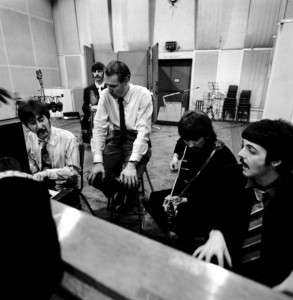 And then there’s the song’s haunting, dreamlike music: the eerie opening sound of the Mellotron; the heavy, dirge-like drums; the delicate placement of the zither-like swarmandal chords; the desperate, piping trumpets and droning cellos. Producer George Martin and sound engineer Geoff Emerick pushed their prodigious skills to the limit to satisfy John’s ever-changing demands for an otherworldly sound. Tape speeds were altered, tracks were played backwards and numerous song versions were spliced together – with nothing more at the engineers’ disposal than editing scissors, two tape machines, and a vari-speed control. It’s no wonder the song took five weeks and 45 hours to record! It’s the Beatles’ masterpiece.
And then there’s the song’s haunting, dreamlike music: the eerie opening sound of the Mellotron; the heavy, dirge-like drums; the delicate placement of the zither-like swarmandal chords; the desperate, piping trumpets and droning cellos. Producer George Martin and sound engineer Geoff Emerick pushed their prodigious skills to the limit to satisfy John’s ever-changing demands for an otherworldly sound. Tape speeds were altered, tracks were played backwards and numerous song versions were spliced together – with nothing more at the engineers’ disposal than editing scissors, two tape machines, and a vari-speed control. It’s no wonder the song took five weeks and 45 hours to record! It’s the Beatles’ masterpiece.
John and Paul truly did leave their hearts in Liverpool. By the time they recorded “Penny Lane” and “Strawberry Fields Forever” – songs originally intended for the upcoming “Sgt. Pepper’s Lonely Hearts Club Band” LP, the groundbreaking album that defined the psychedelic Summer of Love – the Beatles had literally seen it all. They had set the decade’s trends in music, fashion, lifestyle, and mind-altering substances, but they longed for simplicity and solitude, often yearning to “get back” to where they once belonged. They ruled a modern world, but they never forgot their roots. While their songs rarely referred specifically to their hometown lives and loves, their music was always full of the scrappy soul of working-class Liverpool.
Here’s the ultimate music video, from 1967! Is John saying “I buried Paul”…or “cranberry sauce?” at the end? You be the judge.
And now we’ll pick up the mood a bit. I don’t want you to go away in a funk.
© Dana Spiardi, Feb 19, 2014
]]>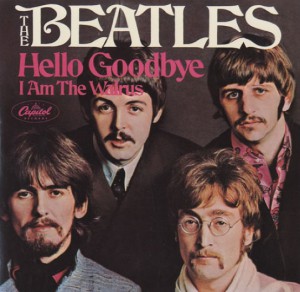 When the song was completed, Paul felt it lacked something. So he asked recording engineer Geoff Emerick if they could add some heavy echo to Ringo’s tom-toms. And, voila! The song goes out with a bang. John Lennon said that the ending was the only part he liked, in fact. He referred to the remainder as “three minutes of contradictions and meaningless juxtapositions,” saying it “smells a mile away.” Hmmm, maybe he was bitter that his composition, “I Am The Walrus,” was chosen as the B side of the single. Oh, that John and his show-offy lyrics!
When the song was completed, Paul felt it lacked something. So he asked recording engineer Geoff Emerick if they could add some heavy echo to Ringo’s tom-toms. And, voila! The song goes out with a bang. John Lennon said that the ending was the only part he liked, in fact. He referred to the remainder as “three minutes of contradictions and meaningless juxtapositions,” saying it “smells a mile away.” Hmmm, maybe he was bitter that his composition, “I Am The Walrus,” was chosen as the B side of the single. Oh, that John and his show-offy lyrics!
You might need to wear sunglasses while watching this video. The colors are that extreme. The ‘hela, heba helloa’ ending is the best part – complete with hula dancers and twisting Beatles. Ringo looks adorable. John can really shake it up, but, blimey! He must be blind without his granny glasses. Oh, the days of wine and acid.
© Dana Spiardi, Dec 30, 2012
]]>